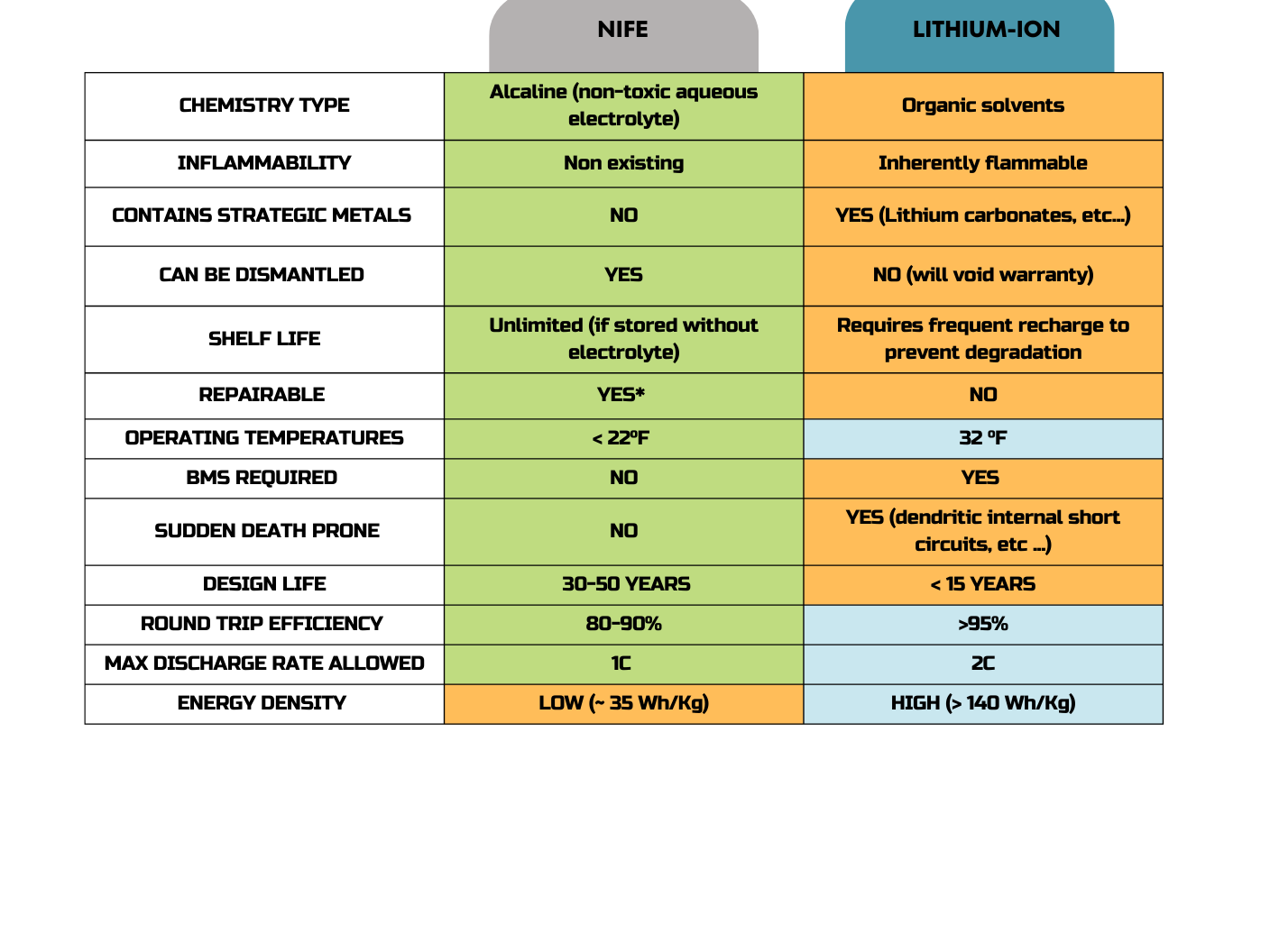Why The Edison battery is the superior choice for off-grid systems ?
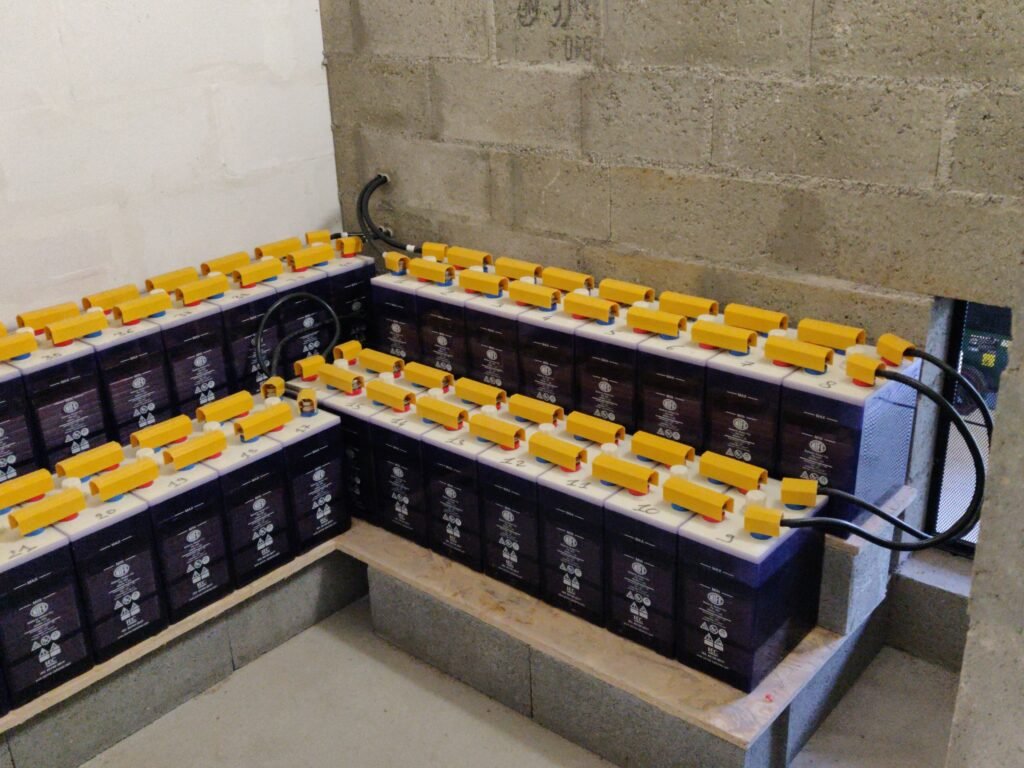
Off-grid solar systems provide a crucial solution for energy independence, particularly in remote locations where access to the grid is limited or nonexistent. A key component in these systems is the energy storage unit, and choosing the right type of battery is essential to ensure long-term reliability and performance. Among the various battery technologies available, we think that the Edison battery (NiFe) stand out as the superior choice in terms of durability, making them particularly well-suited for off-grid applications.
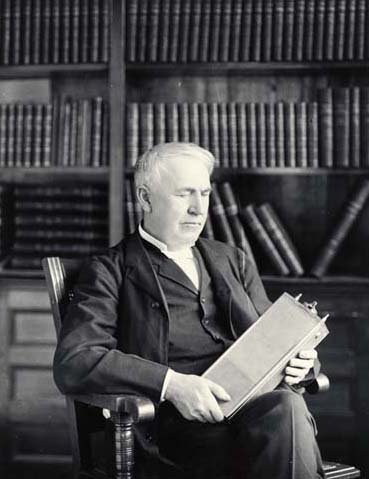
Electrochemistry 101 : understanding the Edison battery magic :
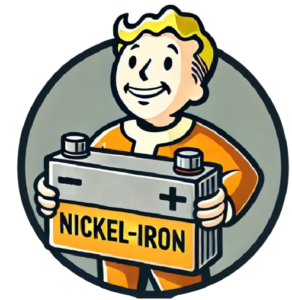
Edison batteries (Nickel-Iron) are based on a simple but effective electrochemical reaction between nickel (Ni) and iron (Fe). These batteries consist of an electrolyte, typically potassium hydroxide (KOH), which facilitates the movement of ions between the nickel and iron electrodes.
Both the Nickel and the Iron electrodes have extremely low solubility rates in an highly alcaline (PH 14) solution. This is a double-edged word : on one hand you get almost an indescrutible battery given that their electrodes cannot be structurally altered, but on the other hand, this comes to a significant internal resistance that impairs global cell efficiency and limits high discharge rates.
Regardless, you get the point : the result is a robust, low-maintenance battery that can withstand demanding conditions and operate efficiently over long periods of time, thus bringing peace of mind to it’s user. It’s like if the electrolyte acts as a metal preservative, thus allowing for decades of trouble-free battery operation.
What’s more, the Edison battery can be set apart from other battery technologies, such as lead-acid or lithium-ion, because their ability to endure extreme conditions without significant degradation in performance is unmatched. For instance, lead acid will be severely damaged if they’re accidentally overdischarged to 100%. Nickel-Iron on the other hand will be unfazed by such abuse. Furthermore, if you overcharge a lead acid, it can destroy the battery and lead to severe complications such as sulfatation. This is not the case, as Nickel-Iron batteries can endure overcharging regimes, and the only thing that will happen is that water breakdown and hydrogen generation will take place at a faster pace (due to electrolysis).
Let’s take a closer look at the factors that contribute to the superior durability of NiFe batteries.
The electrochemistry behind the Edison battery. It's all about solubility !
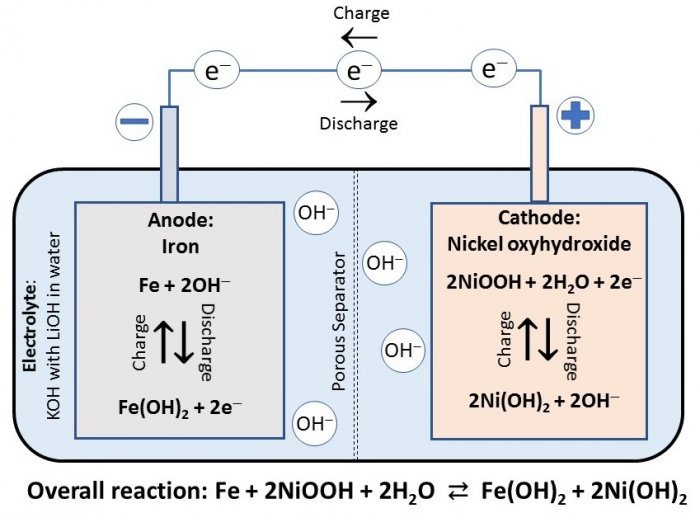
Did you know ?
Furthermore, the operation of an alkaline battery such as the Edison battery relies on an electrolyte that does not recombine with the reactants during cycling, unlike lead-acid batteries (PbSO4 & H2SO4). The chemical role of the electrolyte in a Ni-Fe battery is solely to enable ionic conductivity between the cells through OH- exchange. As a result, the density of the electrolyte in a Nickel-Iron battery remains unchanged, and the risk of stratification due to partial states of charge is eliminated, enabling subsequent capacity additions.
The lifespan of an Edison battery, what can be expected ?
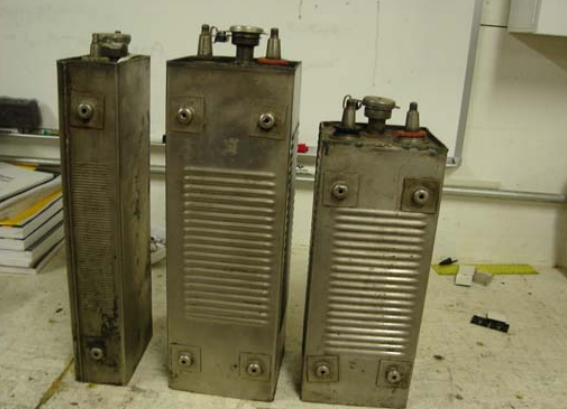
Old Edison cells manufactured in the 1920's. They were stored in a wooden shed in the Adirondack Mountains.
One of the most compelling reasons to choose Nickel-Iron batteries for off-grid solar systems is their extraordinary lifespan. Unlike lead-acid batteries, which typically last around 5-15 years for the best of them (OPZ type), NiFe batteries can last more than 30 years with proper maintenance. This longevity is due to the unique characteristics of the Nickel-Iron chemistry, which allows these batteries to endure countless charge and discharge cycles without significant degradation.
The long lifespan of Nickel-Iron batteries makes them an ideal choice for off-grid systems, where reliability is crucial. With fewer battery replacements required over time, the cost of ownership is significantly lower, making them a more economical choice in the long run.
We will focus on an experiment conducted by Peter J. DeMar, of Battery Research and Testing Inc, NY USA. In 2011, he was able to get his hands on real life aged 80+ year old Nickel-Iron cells that are still functional, although they were stored for decades in harsh conditions.
After reconditioning the cells by flushing the electrolyte, they could recover a age-related reduced discharge rate for a full five hour. In other words, the batteries suffered only a 1% per year de-rating factor (aging factor) for a 80 year old cell.
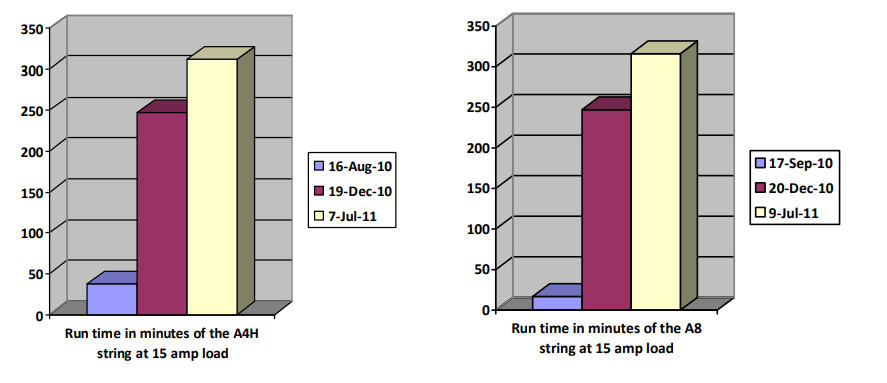
Run time comparison before and after electrolyte change. The capacity was almost fully recovered.
Ruggediness : high tolerance to abuse and temperatures
Off-grid solar systems often require batteries that can handle deep discharges without affecting their performance. Many traditional batteries, such as lead-acid, suffer from reduced lifespan and efficiency when discharged too deeply. In contrast, Nickel-Iron batteries are designed to tolerate deep discharges without suffering from the same issues. This feature makes them particularly well-suited for off-grid applications where the battery may need to discharge to a low level before being recharged by the solar panels.
Nickel-Iron batteries can be discharged up to 100% of their capacity without damaging the battery or causing a significant loss in performance. This resilience to deep discharge is a critical advantage in off-grid systems, where energy availability can be unpredictable, especially during cloudy weather or long periods of low sunlight.
Temperature extremes can have a severe impact on battery performance, particularly in outdoor or remote settings. Many battery technologies, such as lead-acid and lithium-ion, struggle in extremely cold or hot environments, leading to reduced efficiency, capacity loss, and potential failure. Nickel-Iron batteries, however, are highly resistant to temperature fluctuations, making them ideal for off-grid solar systems that may be exposed to harsh weather conditions.
Whether in freezing cold or scorching heat, Nickel-Iron batteries maintain their performance and structural integrity. This characteristic ensures that off-grid solar systems remain operational even in areas with extreme temperatures, such as rural locations in colder or desert climates. However, do not forget that low temperatures will impair discharging performances and capacity.
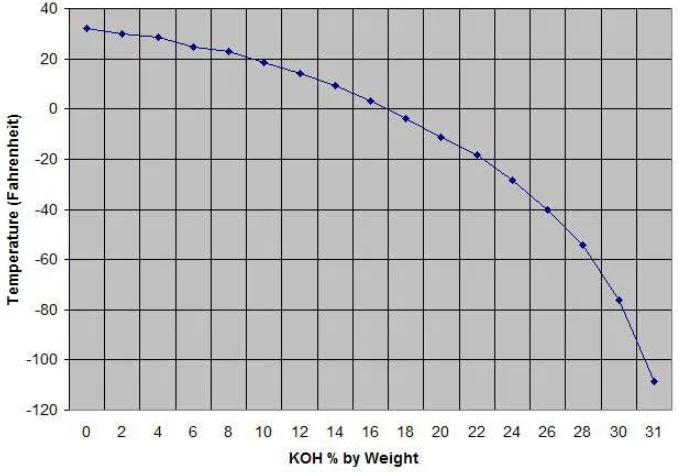
The higher the KOH concentration, the better the low temperature tolerance.
Off-grid solar systems are often used in remote locations where environmental conditions can be harsh, such as in deserts, mountains, or coastal regions. In such settings, battery durability is crucial to ensure the system continues to function reliably. Nickel-Iron batteries, thanks to their tubular construction, are built to withstand physical abuse, vibration, and other stressors that would cause traditional batteries to fail.
Their tough, corrosion-resistant construction and ability to perform under challenging conditions make them a perfect fit for off-grid environments where reliability is paramount. Nickel-Iron batteries also have a high tolerance to overcharging, which can be common in solar systems where charge controllers may not always be perfectly calibrated.
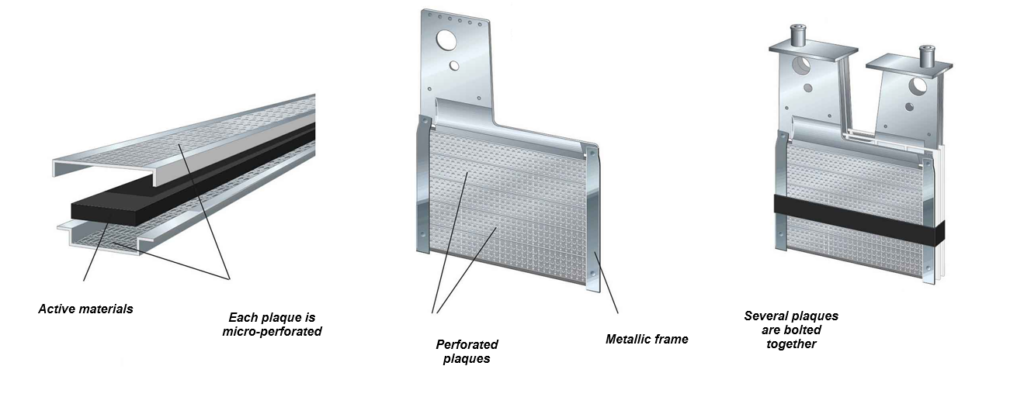
Electrolyte change : why and when ?
Over the long term, potassium hydroxide (KOH) in the electrolyte of a nickel-iron cell absorbs carbon dioxide (CO²) from the air, recombining in the electrolyte to form potassium carbonate, K²CO3 (carbonation). These carbonate deposits do not damage the cells, but they can lead to a significant reduction in capacity by altering the ionic conductivity of the electrolyte solution. The higher the discharge current, the more pronounced the effect. Although there is no precise consensus on the subject in the technical literature (it is very difficult indeed, given the life span of a Ni-Fe battery, which extends over several decades, to monitor performance with or without electrolyte change), we recommend a total electrolyte change every 10-15 years to revive battery performance
Some carbonate build-up on +80 years old cells. Time to flush the electrolyte !
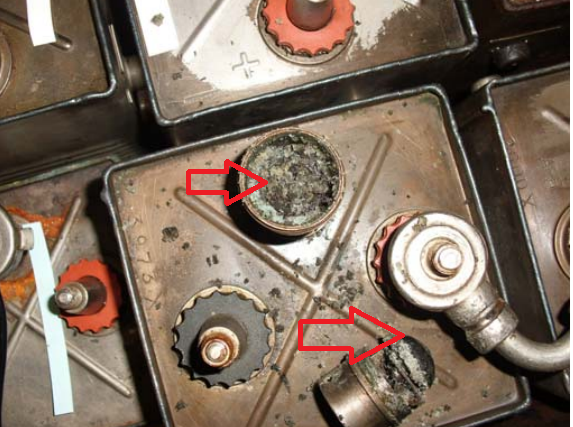
Did you know ?
It is accepted that a carbonate level of up to 80-100g/L for a nickel-iron cell is tolerable.
The KOH concentration of the electrolyte may also decrease significantly over long periods. During recharging, part of the electrolyte is evaporated when the cell is degassed, and a small amount of KOH is lost in this way. In addition, regular topping-up can accentuate this depletion and lower the KOH concentration. One way of measuring electrolyte density is to use a battery densimeter (or acid scale) to check the concentration. When it falls below 1.160, it’s time to change the solution entirely.
Edison battery vs Lithium : who wins ?
In terms of ruggedness, a lithium-ion battery will be inherently fragile as it relies exclusively on a small piece of equipment called the BMS ("battery management system").
J.Allera.
The table below show the main differences between two completely different technologies, separated by one century of innovation : lithium-ion (LiFePO4 mostly) and Nickel-Iron.
You will notice that the NIFE column is a lot greener than the Lithium-Ion. We didn’t make this up ! In fact, regarding all the criterias that we think are important in an off-grid scenario, the lithium-ion battery globally fails to deliver.
Of course, if one only evaluates a battery in terms of round-trip efficiency, footprint absence of maintenance and modularity, then the lithium-ion battery wins hands down.
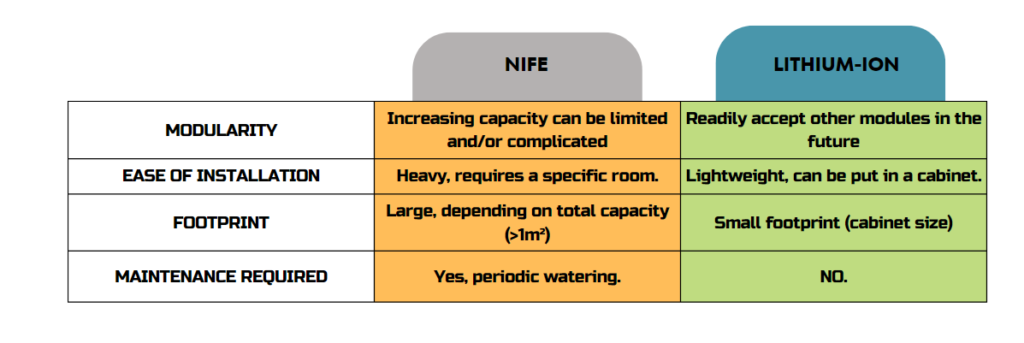
Lithium-ion batteries wins on some aspects !
However, instance in terms of ruggedness, a lithium-ion battery will be inherently fragile as it relies exclusively on a small piece of equipment called the BMS (“battery management system”). This unit ensures all cells voltages within the battery remains consistent, and are not getting over/undercharged, as the consequences can be catastrophic (cell explosion and irreversible damages). If this BMS doesn’t work, then it’s the whole battery pack that is off-service.
But let's get down to the nitty-gritty....
